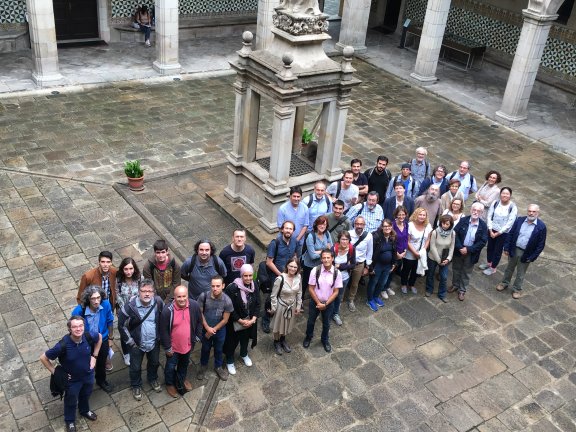2a Jornada
La 2a Jornada de Sistemes Dinàmics a Catalunya es va celebrar Dimecres 4 d'octubre de 2017 a la sala Pere i Joan Coromines de l'Institut d'Estudis Catalans. Durant la jornada es va procedir a l'entrega del "Barcelona Dynamical Systems Prize".

Comitè Organitzador: Josep Maria Cors (UPC), Xavier Jarque (UB) i Joan Torregrosa (UAB).
Comitè Científic: Armengol Gasull (UAB) i Àngel Jorba (UB).
| 9:30 | Presentació |
| 9:45-10:45 | Amadeu Delshams (UPC) "Arnold diffusion for dummies" |
| 10:45-11:30 | Pausa - Café |
| 11:30-12:30 | Jaume Llibre (UAB) "On the central configurations of the N-body problem" |
| 12:35 | Foto de grup |
| 13:00-15:00 | Dinar |
| 15:15-16:15 | Jordi-Lluís Figueras (Uppsala Universitet), Àlex Haro (UB), Alejandro Luque (ICMAT) "Rigorous Computer-Assisted Application of KAM Theory: A Modern Approach" "Varietats parabòliques i el mètode de la parametrització" Barcelona Dynamical Systems Prize 2017 |
"Arnold Diffusion for dummies"
Amadeu Delshams (UPC)
V.I. Arnold gave in 1963 the first complete proof of the KAM theorem (Kolmogorov-Arnold-Moser) on the preservation of a large part of the invariant tori of a nearly integrable Hamiltonian system. A year later, in a four-page article, he showed an example of global instability of an action variable in a system arbitrarily close to an integrable Hamiltonian system. This phenomenon was named Arnold diffusion by Chirikov, and was conjectured that it was generic. Although there have been several recent advances to prove this conjecture, using geometric, variational, or other methods, the conjecture remains open, although it is commonly accepted as true.
In this talk I shall try to review the most important contributions to prove this Arnold's conjecture as well as to present the present state of the art.
"On the central configurations of the N-body problem"
Jaume Llibre (UAB)
The N-body problem consists in study the motion of N pointlike masses, interacting among themselves through no other forces than their mutual gravitational attraction according to Newton's gravitational law. Since the general solution of the N-body problem cannot be given, great importance has been attached from the very beginning to the search for particular solutions where the N mass points fulfilled certain initial conditions. By studying of a class of particular solutions called homographic appeared the notion of central configurations of the N-body problem.
Central configurations are important because
- They allow to compute all the homographic solutions.
- If the N bodies are going to a simultaneous collision, then the particles tend to a central configuration.
- If the N bodies are going simultaneously at infinity in parabolic motion (i.e. the radial velocity of each particle tends to zero as the particle tends to infinity), then the particles tend to a central configuration.
- There is a relation between central configurations and the bifurcations of the hypersurfaces of constant energy and angular momentum.
- Central configurations provides good places for the observation in the solar system, as for instance in the SOHO project.
The goal of this talk is to do a survey on what is known on central configurations, and on some new results on them, specially on the spatial central configurations.
"Rigorous Computer-Assisted Application of KAM Theory: A Modern Approach"
Jordi-Lluís Figueras (Uppsala Universitet) , Àlex Haro (UB) and Alejandro Luque (ICMAT)
We present and illustrate a general methodology to apply KAM theory in particular problems, based on an a posteriori approach. We focus on the existence of real analytic quasi-periodic Lagrangian invariant tori for symplectic maps. The purpose is to verify the hypotheses of a KAM theorem in an a posteriori format: Given a parameterization of an approximately invariant torus, we have to check non-resonance (Diophantine) conditions, non-degeneracy conditions and certain inequalities to hold. To check such inequalities, we require to control the analytic norm of some functions that depend on the map, the ambient structure and the parameterization. To this end, we propose an efficient computer-assisted methodology, using fast Fourier transform, having the same asymptotic cost of using the parameterization method for obtaining numerical approximations of invariant tori. We illustrate our methodology by proving the existence of invariant curves for the standard map (up to epsilon =0.9716), meandering curves for the non-twist standard map and 2-dimensional tori for the Froeschlé map.
